2017 Superbike Spec Chart Shootout

Comparing the 2017 literbike crop by the numbers
As far as 2017 is concerned, this might be the year we remember as the one that saw the entire liter-class field go electric. No, I don’t mean like that. I mean electronic rider aids – every major player in the field has them now. Honda and Suzuki, with their CBR1000RR and GSX-R1000, respectively, had held out on introducing riding aids (beyond differing power modes in the Suzuki’s case) until this year. Meanwhile, the rest of the competition has leap-frogged ahead, introducing highly advanced traction control, wheelie control, launch control, slide control, and all kinds of other controls previously only seen on MotoGP machines.
Today, all of this power is available to the common man – or woman – to do with as they please. Whether it’s finding a way to lap a racetrack as fast and safely as possible, or simply having the safety net there when the unexpected happens on your Sunday ride, modern sportbikes have now become highly advanced computers on wheels.
Of course, we wouldn’t even need all this wizardry if these bikes weren’t pumping out close to 200 hp. But in this land of excess we’re glad such motorcycles exist, which is why we’re hard at work putting together Motorcycle.com’s 2017 Literbike Shootout – not only to see how the new Honda and Suzuki stack up against the competition, but also to see how small revisions have affected certain models, and to see how other models that haven’t changed still perform.
We’re shooting to bring that test to you in the coming months, but for now the best we can do is bench race based on the specs provided by the different manufacturers, and from our past experience riding (most) these bikes during the Street, Track, and Overall portions of our 2015 Literbike Shootout.
The Contenders
For 2017 we’re bringing back much of the same group we featured during our test two years ago. This includes the BMW S1000RR, Yamaha YZF-R1, and Kawasaki ZX-10R, all of which come back largely unchanged. The Aprilia RSV4 RR will also make a return, but with a couple minor revisions for 2017 mostly centered around – you guessed it – electronics. Then we have the updated Honda CBR1000RR and Suzuki GSX-R1000 (single R). To add a little bit of spice to this mix, we’re also throwing in a EBR 1190RX (yes, really!), and MV Agusta F4 (if we can get one).
Where’s the Ducati 1299 Panigale, you ask? Good question. Like our 2015 test, Ducati won’t be providing a 1299 for 2017 (if you’ll remember, a kind reader allowed us to borrow his own personal bike!) though we’re told this is because Ducati has chosen not to include any 1299 Panigales within its press fleet for this year. As such, be warned that Team Ducati won’t be represented in our test, though we’ll include its specs here for comparison purposes.
By The Numbers
At $13,995, some might be surprised to discover the EBR 1190RX is the least expensive of the group. Next come the Japanese contenders, starting with the $14,599 Suzuki GSX-R1000 ($14,999 with ABS), $15,099 Kawasaki ZX-10R ($16,099 with ABS), $16,499 Honda CBR1000RR, and $16,699 Yamaha YZF-R1. The Europeans occupy the upper end of the pay scale, as the $16,999 Aprilia RSV4 RR is followed by the $19,798 MV Agusta F4, and finally, the Ducati 1299 Panigale at $19,995.
Where’s the BMW, you ask? With its $15,695 base price, the BMW S1000RR is extremely competitive on price with the Japanese machines, slightly more expensive than the Kawasaki but less so the Honda. However, this price is for the standard bike with no options; good luck actually finding one so equipped – that seems to be a special-order kind of thing. Two years ago, our test S1000RR was nearly $20,000 after adding in all the bells and whistles it came equipped with. There’s no reason to believe BMW won’t be giving us a S1000RR similarly equipped, which would put its as-tested price up there with the most expensive in this group.
Enough with the price, though. Literbike customers (or potential customers) know this decision will make a hole in their wallet. What it comes down to is whether the model they’re looking at packs the goods. Since we’re looking at the base models of all these machines (or the mid-level model in the Yamaha’s case), none come equipped with electronic suspension. That’s an option saved for the higher-tiered versions of most of the models here. But that’s not to say the analog components aren’t up to the task. They absolutely are.
That said, when it comes to liter-class sportbikes, perhaps the number more important than price is power. This is where things get really impressive. With only 156 horses to the wheel, when measuring its 1190SX naked bike cousin on the MotoGP Werks dyno (the two share the same engine), the EBR would theoretically bring up the rear of this group. Granted, 156 hp is nothing to sneeze at, but it pales in comparison to some of its competitors.
In 2015, we saw 175 horses or more at the rear wheel in the Aprilia (175.8), BMW (182.9), and Ducati (175.0), with the Japanese bikes being a bit more conservative in the 160s. While we don’t have the new Fireblade or Gixxer 1000 yet to dyno, their manufacturers are claiming 189.1 and 199 crankshaft horsepower, respectively. If we throw in the MV Agusta, with its claimed 195 crankshaft horses, that makes three more models in 2017 surpassing the 175 wheel-horsepower claim, assuming a 10% driveline loss.
It’s not everyday we scoff at 72 lb-ft of torque, but in this group, this is the amount the crossplane-crank Yamaha R1 produced two years ago, placing it in last. From there, the torque figures, both claimed (minus 10% loss) and tested vary from the mid to upper 70s, to the low 80s. However, by virtue of being a big, booming V-Twin with more displacement than the rest, the 1299 Panigale brings home the torque crown – the 1285cc Ducati putting down a whopping 92.5 lb-ft when we last had it on the dyno.
Power Is Nothing Without Control
It goes without saying, even 72 lb-ft of torque and 180-odd horses are more than enough to spin rear tires and cause a good day to go bad in a hurry. Taming this power not only leads to safer rides, but potentially faster laps – at least for mere mortals like us. So let’s take a look at how the different OEMs choose to do so.
For starters, all but the EBR come with ABS. Some have it as an option, while others go even further and incorporate cornering ABS into its set of algorithms. How so? Through an inertial measurement unit, better known as an IMU (again, used on all the bikes except the EBR and MV Agusta). The IMU reads the motorcycle’s movements in either five or six axis several times per second to best understand the bike’s trajectory. It’s this technology (and wheel-speed sensors) that nearly every bike here relies on for its traction-control systems.
Should the rider make the bike go out of line with the predetermined traction-control values, the IMU will likely detect it before the rider does, setting off a chain of commands to get things in order. But this mostly applies when the settings are pointed in the most restrictive of the range. Turning down the dial and giving more freedom back to the rider allows for better lap times, but at the cost of the rider’s safety net. Here, the IMU will allow for greater slip before telling the ECU to go into action – so much so that it’s entirely possible for someone to highside with gratuitous throttle application while leaned over.
Since five of the seven bikes here already have an IMU, other functions it can control are wheelies, launches, and rear-wheel lift mitigation. The first two control power under acceleration, while the latter is an attempt to control braking power to keep the rear wheel down. As for the EBR and MV, these models still rely on either wheel or crankshaft sensors to calculate rate-of-change between wheel or engine speed and the amount of throttle applied. These methods react to the slip, whereas the IMU-equipped bikes try and predict slip and react accordingly.
Each manufacturer has their own set of algorithms set into the ECUs, based on what they think is the best way to deal with the power and what the rider is trying to do with it. Our job, then, is to attempt to determine which one does it best, while also seeing which one can lay down the quickest lap time.
In the two years since we last did this test, nearly every major manufacturer of sportbikes has adopted the IMU and how best to utilize it. A lot has changed in the sportbike world since 2015, and while we’re under no illusions it’ll be easy to evaluate each system, there’s no doubt we’re excited to get started!
Hover over the image below to see the complete spec chart for each bike.
2017 Literbike shootout spec chart | |||||||||
|---|---|---|---|---|---|---|---|---|---|
Aprilia RSV4 RR | BMW S1000RR | Ducati 1299 Panigale | EBR 1190RX | Honda CBR1000RR | Kawasaki Ninja ZX-10R | MV Agusta F4 RR | Suzuki GSX-R1000 | Yamaha YZF-R1 | |
| MSRP | $16,999 | $15,695 | $19,995 | $13,995 | $16,499 | $15,099 ($16,099 w/ABS) | $19,798 | $14,599 ($14,999 ABS) | $16,699.00 |
| Type | 999.6cc Liquid-cooled, DOHC, four-stroke, 65-degree V4, 4 valves per cylinder | 999cc Liquid-cooled, DOHC, four-stroke, inline-Four, 4 valves per cylinder | 1285cc Liquid-cooled, DOHC, L-Twin, four-stroke, Desmodromic valve actuation | 1190cc liquid-cooled, DOHC, 72-degree V-Twin, four-stroke, 4 valves per cylinder | 999cc Liquid-cooled, DOHC, four-stroke, inline-Four, 4 valves per cylinder | 998cc Liquid-cooled, DOHC, four-stroke, inline-Four, 4 valves per cylinder | 998cc, Liquid-cooled, DOHC, four-stroke, inline-Four, 4 valves per cylinder | 999.8cc, Liquid-cooled, DOHC, four-stroke, inline-Four, 4 valves per cylinder | 998c Liquid-cooled, DOHC, four-stroke, Cross-plane inline-Four, 4 valves per cylinder |
| Bore and Stroke | 78.0mm x 52.3mm | 80.0mm x 49.7mm | 116.0mm x 60.8mm | 106mm x 67.5mm | 76.0mm x 55.0mm | 76.0mm x 55.0mm | 79.0mm x 50.9mm | 76.0mm x 55.1mm | 79.0mm x 50.9mm |
| Compression Ratio | 13.6:1 | 13.0:1 | 12.6:1 | 13.4:1 | 13.0:1 | 13.0:1 | 13.4:1 | 13.2:1 | 13.0:1 |
| Rear Wheel Horsepower | 175.8 hp @ 12,400 rpm | 182.9 hp @ 13,100 rpm | 175.0 hp @ 10,400 rpm | 156.0 @ 10,700 rpm (1190SX) | 189.1 (crank) hp @ 13,000 rpm (claimed) | 160.6 hp @ 11,700 rpm | 195 (crank) hp @ 13,400 rpm (claimed) | 199 (crank) hp @ 13,200 rpm (claimed) | 162.9 hp @ 12,300 rpm |
| Torque | 76.7 lb.-ft. @ 10,800 rpm | 79.9 lb.-ft. @ 9600 rpm | 92.5 lb.-ft. @ 8900 rpm | 83.0 lb-ft @ 8100 rpm (1190SX) | 84.1 (crank) lb-ft @ 11,000 rpm (claimed) | 73.6 @ 11,200 rpm | 81.7 (crank) lb-ft @ 9600 rpm (claimed) | 86.7 (crank) lb-ft @ 10,800 rpm (claimed) | 72.5 lb.-ft. @ 8900 rpm |
| Transmission | 6-speed; multi-plate wet clutch w/slipper function | 6-speed; multi-plate wet clutch w/slipper function | 6-speed; multi-plate wet clutch w/slipper function | 6-speed; multi-plate wet clutch w/vacuum operated slipper function | 6-speed; multi-plate wet clutch w/slipper function | 6-speed, multi-plate wet clutch w/slipper function, positive neutral finder | 6-speed, multi-plate wet clutch w/slipper function | 6-speed, multi-plate wet clutch w/slipper function | 6-speed; multi-plate wet clutch w/slipper function |
| Final Drive | Chain | Chain | Chain | Chain | Chain | Chain | Chain | Chain | Chain |
Aprilia RSV4 RR | BMW S1000RR | Ducati 1299 Panigale | EBR 1190RX | Honda CBR1000RR | Kawasaki Ninja ZX-10R | MV Agusta F4 RR | Suzuki GSX-R1000 | Yamaha YZF-R1 | |
| Front Suspension | Sachs 43mm fork, fully adjustable | 46mm fork, fully adjustable | Marzocchi 50mm fully adjustable USD fork. | 43mm Showa Big Piston Fork, fully adjustable | 43mm Showa Big Piston Fork with spring-preload, rebound and compression damping-adjustability | 43mm inverted Balance Free Fork, adjustable stepless rebound and compression damping, spring preload adjustability | Marzocchi 50mm fully adjustable USD fork | 43mm Showa Big Piston Fork, fully adjustable | 43mm KYB inverted fork; fully adjustable |
| Rear Suspension | Sachs monoshock with piggyback reservoir, fully adjustable | Fully adjustable monoshock | Fully adjustable Sachs shock. Adjustable linkage: Progressive/flat. Aluminium single-sided swingarm | Showa linkage-less single shock, fully adjustable | Showa Balance Free Rear Cushion shock, with spring-preload, rebound and compression-damping adjustability | Horizontal back-link with Balance Free gas-charged shock, stepless, dual-range (low-/high-speed) compression damping, stepless rebound damping, fully adjustable spring preload | Fully adjustable Sachs shock, w/high- and low-speed compression adjustment | Fully adjustable Showa shock, w/high- and low-speed compression adjustment | KYB Single shock w/piggyback reservoir, hi/low speed compression, rebound and preload adjustibility |
| Front Brake | Dual 330mm rotors. Twin Brembo M50 monoblock radial 4-piston calipers. ABS with switchable Rear Lift-up Mitigation | Dual 320mm rotors. Twin radial-mount 4-piston calipers. Switchable ABS | Dual 330mm rotors. Twin Brembo M50 monoblock, radial-mount calipers. Cornering ABS standard | 386mm single perimeter rotor, 8-piston caliper. No ABS. | Dual 320mm rotors. Dual radial-mount 4-piston Tokico calipers | Dual 330mm petal rotors, Brembo M50 4-piston radial-mount calipers w/ABS | Dual 320mm rotors, Brembo 4-piston radial-mount calipers w/ABS | Dual 320mm rotors, Brembo 4-piston radial-mount calipers w/ABS | Dual 320mm rotors, 4-piston calipers, UBS, ABS |
| Rear Brake | 220mm rotor. Brembo twin-piston caliper | 220mm rotor. Single-piston caliper | 245mm rotor. Twin-piston caliper w/Cornering ABS standard | 220mm rotor. 2-piston caliper | 220mm rotor, single-piston caliper w/ABS | 220mm petal rotor, single-piston caliper w/ABS | 210mm rotor, Nissin 4-piston caliper w/ABS | 220mm rotor, Nissin single-piston caliper w/ABS | 220mm rotor, UBS, ABS |
Aprilia RSV4 RR | BMW S1000RR | Ducati 1299 Panigale | EBR 1190RX | Honda CBR1000RR | Kawasaki Ninja ZX-10R | MV Agusta F4 RR | Suzuki GSX-R1000 | Yamaha YZF-R1 | |
| Front Tire | 120/70-17 | 120/70-17 | 120/70-17 | 120/70-17 | 120/70-17 | 120/70-17 | 120/70-17 | 120/70-17 | 120/70 ZR-17 |
| Rear Tire | 200/55-17 | 190/55-17 | 200/55-17 | 190/55-17 | 190/50-17 | 190/55-17 | 200/55-17 | 190/55-17 | 190/55 ZR-17 |
| Rake/Trail | 26.5 deg/4.1 in | 23.5 deg / 3.9 in. | 24.0 deg / 3.8 in. | 22.4 deg / 3.8 in. | 23.3 deg / 3.8 in. | 25 deg / 4.2 in. | TK / 3.9 in. | 23.2 deg. / 3.7 in. | 24 deg / 4.0 in. |
| Wheelbase | 56.5 in. | 56.6 in. | 56.6 in. | 55.5 in. | 55.3 in. | 56.7 in. | 56.3 in. | 55.5 in. | 55.3 in. |
| Seat Height | 33.0 in. | 32.7 in. | 32.7 in. | 32.5 in. | 32.8 in. | 32.9 in. | 32.7 in. | 32.5 in. | 33.7 in. |
| Curb Weight | 450 lbs. (claimed) | 420 lbs. (claimed) | 427 lbs. | 450.5 lbs. (calculated) | 425 lbs. (Euro-spec) | 454.2 lbs. | 421.1 lbs (claimed dry weight) | 443.0 lbs, 445.0 lbs(CA, both claimed weights) | 438 lbs. |
| Fuel Capacity | 4.9 gal. | 4.5 gal. | 4.5 gal. | 4.5 gal. | 4.2 gal. | 4.5 gal. | 4.5 gal. | 4.2 gal. | 4.5 gal. |
Aprilia RSV4 RR | BMW S1000RR | Ducati 1299 Panigale | EBR 1190RX | Honda CBR1000RR | Kawasaki Ninja ZX-10R | MV Agusta F4 RR | Suzuki GSX-R1000 | Yamaha YZF-R1 | |
| ABS | X | X | X | X | X | X | X | X | |
| Cornering ABS | X | X | Available on SP model | X | Available on GSX-R1000R | ||||
| Magnesium wheels | X | ||||||||
| Forged aluminum wheels | Optional | Available on S model | |||||||
| Titanium connecting rods | X | X | |||||||
| Titanium valves | X | X | X | X | X (intake only) | ||||
| Aluminum fuel tank | Titanium tank available on SP model | X | |||||||
| Smartphone app | X | Optional | |||||||
| Electronic suspension | Optional (included as tested) | Available on S model | Available on SP model | ||||||
| Quickshifter | X | Optional (included as tested) | X | Optional | Optional (standard on SP model) | X | Optional | Optional | X |
| Clutchless downshift ability | X | Optional (included as tested) | X | Optional (standard on SP model) | |||||
Aprilia RSV4 RR | BMW S1000RR | Ducati 1299 Panigale | EBR 1190RX | Honda CBR1000RR | Kawasaki Ninja ZX-10R | MV Agusta F4 RR | Suzuki GSX-R1000 | Yamaha YZF-R1 | |
| Power modes | X | X | X | X | X | X | X | X | |
| Traction control | X | X | X | X | X | X | X | X | X |
| Slide control | X | ||||||||
| Launch control | X | Optional (included as tested) | X | X | X | ||||
| Wheelie control | X | X | X | X | X | X | |||
| Engine brake control | X | X | X | ||||||
| Inertial Measurement Unit | X | X | X | X | X | X | X | ||
| GPS telemetry | Via smartphone app | Optional | Optional | Optional | |||||
Aprilia RSV4 RR | BMW S1000RR | Ducati 1299 Panigale | EBR 1190RX | Honda CBR1000RR | Kawasaki Ninja ZX-10R | MV Agusta F4 RR | Suzuki GSX-R1000 | Yamaha YZF-R1 | |

Troy's been riding motorcycles and writing about them since 2006, getting his start at Rider Magazine. From there, he moved to Sport Rider Magazine before finally landing at Motorcycle.com in 2011. A lifelong gearhead who didn't fully immerse himself in motorcycles until his teenage years, Troy's interests have always been in technology, performance, and going fast. Naturally, racing was the perfect avenue to combine all three. Troy has been racing nearly as long as he's been riding and has competed at the AMA national level. He's also won multiple club races throughout the country, culminating in a Utah Sport Bike Association championship in 2011. He has been invited as a guest instructor for the Yamaha Champions Riding School, and when he's not out riding, he's either wrenching on bikes or watching MotoGP.
More by Troy Siahaan



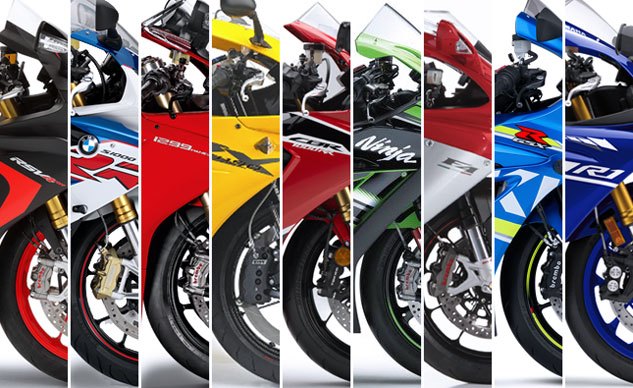
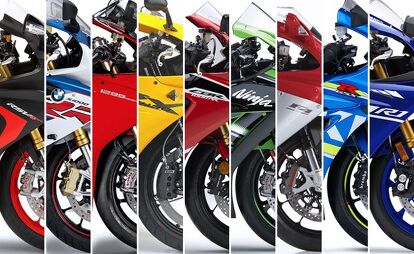





















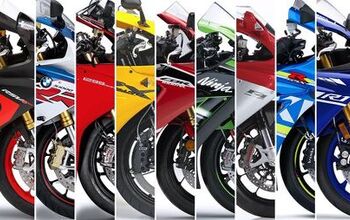
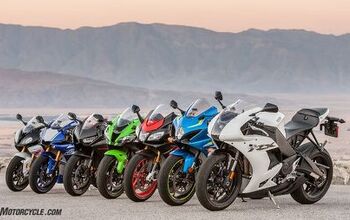
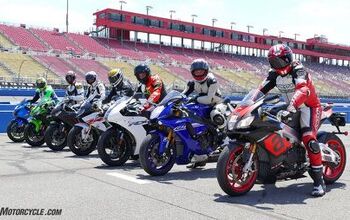














Comments
Join the conversation
KTM has several bikes with an IMU for cornering ABS and cornering Traction control. They are aggressively trying to filter the tech through their whole line up for safety. Electronic Stability Control which an IMU is part of, was mandated in the USA for all non motorcycle vehicles in 2012 as it could save more lives than seat belts by preventing a crash. Europe finally started increased motorcycle safety by requiring new 2017 bikes to have ABS. With more bikes with RBW, ABS and TC should be easier. Hopefully the USA will follow. We should see more LED headlights and adaptive technology for safety. The more expensive bikes allow tech to eventually filter down to the masses. BMW and now Ducati have automobile R&D to speed tech up.
Which bike or bikes have the best launch capability in a quarter mile drag race. I read previously some where that some bikes are difficult to launch from a dead stop because of clutch issues or some other cause. Please advise. Did you all test this capability this time?